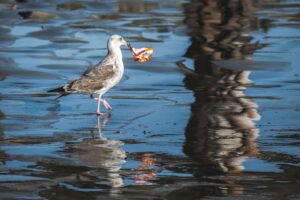Physical Address
23,24,25 & 26, 2nd Floor, Software Technology Park India, Opp: Garware Stadium,MIDC, Chikalthana, Aurangabad, Maharashtra – 431001 India
Physical Address
23,24,25 & 26, 2nd Floor, Software Technology Park India, Opp: Garware Stadium,MIDC, Chikalthana, Aurangabad, Maharashtra – 431001 India

For many, seafood is a dietary staple—an essential protein and a healthy fat source. But beneath the surface of the world’s oceans, something far less appetising is making its way up the food chain. A new study has found that nearly all seafood samples tested in Oregon contained microplastics, adding to growing concerns about the extent of plastic contamination in our food. Scientists warn that plastic particles and synthetic fibres are now so prevalent in marine environments that avoiding them entirely may be impossible. The discovery raises urgent questions about the impact of plastic pollution—not just on aquatic life but on human health.
Nearly All Seafood Samples Contaminated
A team of researchers from Portland State University’s Applied Coastal Ecology lab analysed five types of fish and shrimp sourced from fishing boats and local supermarkets. The findings were alarming: 99% of the seafood tested contained microplastics. The composition of these particles was even more concerning—over 80% were synthetic fibres, most likely shed from clothing and household textiles.
Shrimp and herring contained some of the highest contamination levels, likely because they feed by filtering water, where microplastics accumulate. Swordfish and processed seafood also tested positive, suggesting that plastic particles are present at multiple points in the supply chain. “We found that the smaller organisms that we sampled seem to be ingesting more anthropogenic, non-nutritious particles,” said Professor Elise Granek, one of the study’s authors. The research adds to a growing body of evidence showing that plastic pollution is not just an environmental problem—it is becoming part of the human diet.
What This Means for Human Health
While the full impact of consuming microplastics is still being studied, scientists have raised concerns about their potential health effects. Plastic particles can carry toxic chemicals, including pesticides, flame retardants, and heavy metals. Once inside the body, these substances may interfere with hormone function, contribute to inflammation, and affect metabolism. Microplastics have already been found in human blood, lungs, and placentas, highlighting how deeply they have infiltrated biological systems.
The risks are not just hypothetical. Some research suggests that microplastics can damage cells and trigger stress responses in the body. “If we’re eating seafood regularly, this means we’re regularly consuming plastics that may carry toxic compounds,” Granek said. While it remains unclear exactly how much plastic consumption could lead to harmful effects, the sheer pervasiveness of microplastic pollution suggests that long-term exposure is inevitable.
A Crisis for Marine Life
It’s not just humans who are at risk. Microplastics are now so widespread that marine ecosystems are being fundamentally altered. Filter-feeding species, such as oysters and mussels, have accumulated high levels of plastic particles, which can block digestive tracts and reduce energy intake. This affects the entire food chain, impacting predators and disrupting entire marine populations.
Scientists warn that if plastic pollution continues at current rates, some species could struggle to survive. Marine organisms are already dealing with the pressures of overfishing, climate change, and habitat destruction. The addition of plastic contamination could push some vulnerable populations closer to collapse. “We’re seeing evidence that microplastics are not just present in seafood—they’re becoming a significant stressor on marine life,” said Granek.
What Can Be Done?
Reducing plastic pollution requires systemic change. Scientists point to synthetic clothing as a significant source of microplastics—tiny fibres are shed every time clothes are washed, eventually making their way into rivers and oceans. One potential solution is requiring washing machines to have filters capable of trapping microfibers before they reach wastewater systems. Other recommendations include washing clothes less frequently, using cold water, and switching to natural fibre materials like cotton or wool.
The presence of plastic in seafood is no longer an abstract issue—it’s a reality for consumers around the world. Scientists warn that without urgent action, microplastics will continue to build up in the environment, affecting future generations in ways we are only beginning to understand. As Granek put it, “We need policies that focus on reducing plastic at the source because once it’s in the ocean, it’s challenging to remove.”
For now, the best way to limit exposure is to push for broader change. Consumers, businesses, and policymakers all have a role in tackling the plastic crisis before it becomes irreversible. The question is not whether microplastics are in our food—it’s what we’re willing to do about it.
References:
https://www.frontiersin.org/journals/toxicology/articles/10.3389/ftox.2024.1469995/full
https://www.theguardian.com/us-news/2025/feb/03/seafood-microplastic-contamination-study
https://www.sciencedirect.com/science/article/pii/S2950305124000214
Banner image: Photo by Tim Mossholder on Unsplash
Comments are closed.
Interesting blog! Is your theme custom made oor did you download itt from somewhere?
A desgn like youfs with a few simple addjustements would really make mmy blog stand out.
Please leet mme knmow where yoou gott our design. Thqnk you